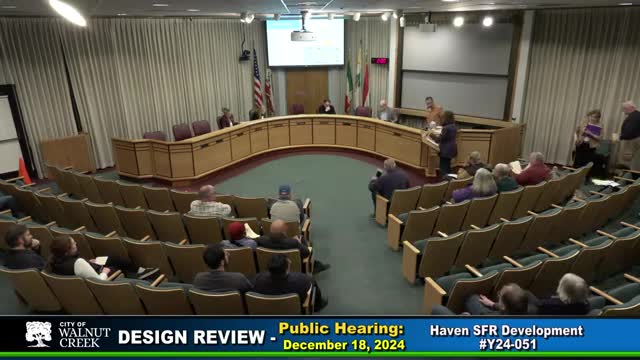Residents raise concerns over Haven's proposed development on Third Avenue
January 13, 2025 | Walnut Creek City, Contra Costa County, California
Thanks to Scribe from Workplace AI and Family Portal , all articles about California are free for you to enjoy throughout 2025!

This article was created by AI using a video recording of the meeting. It summarizes the key points discussed, but for full details and context, please refer to the video of the full meeting. Link to Full Meeting
Debbie Tabalski, a long-time resident of Third Avenue, stepped up to the microphone, her voice tinged with both nostalgia and concern. “I’ve lived here for 25 years,” she shared, reflecting on the charm of the neighborhood, characterized by its single-family ranch-style homes and mature trees. Her worries centered on the removal of 19 trees for the new development, replaced by magnolias that she felt would disrupt the area’s aesthetic. “We’re concerned that this isn’t going to quite fit in with the charming older community,” she stated, highlighting the potential for increased parking congestion as well.
Jim Tuggle, a neighbor across the street, echoed her sentiments, pointing out the inadequacy of the proposed parking solutions. With only six guest parking slots and no driveways, he foresaw a future of overflow parking spilling onto the streets, exacerbating existing issues. “People these days don’t use their garages as garages,” he noted, painting a picture of a congested neighborhood struggling to accommodate new residents.
Cynthia Schneider, living adjacent to the proposed site, raised additional concerns about privacy and the potential for direct sightlines into her backyard from the new two-story buildings. She suggested that there might be room for negotiation with the developers to preserve certain elements of the existing landscape, such as a heritage tree that was slated for removal. Schneider also questioned the concept of “affordable housing” when prices for new units could soar to over a million dollars, expressing a desire for a collaborative approach to the development that would respect both community needs and the developers’ goals.
As the meeting progressed, it became clear that the residents were not against development per se, but rather sought a balance that would maintain the character of their neighborhood while accommodating growth. The discussions highlighted a community grappling with change, where the desire for modernization clashed with the longing for preservation.
The meeting concluded with a sense of urgency for further dialogue between the developers and the community. Residents left with a hope that their voices would be heard, and that together, they could find a path forward that honors both the past and the future of Walnut Creek. As the city continues to evolve, the challenge remains: how to embrace new opportunities while safeguarding the unique charm that makes this community special.
Converted from Walnut Creek Design Review Commission: December 18, 2025 meeting on January 13, 2025
Link to Full Meeting
Comments
View full meeting
This article is based on a recent meeting—watch the full video and explore the complete transcript for deeper insights into the discussion.
View full meeting